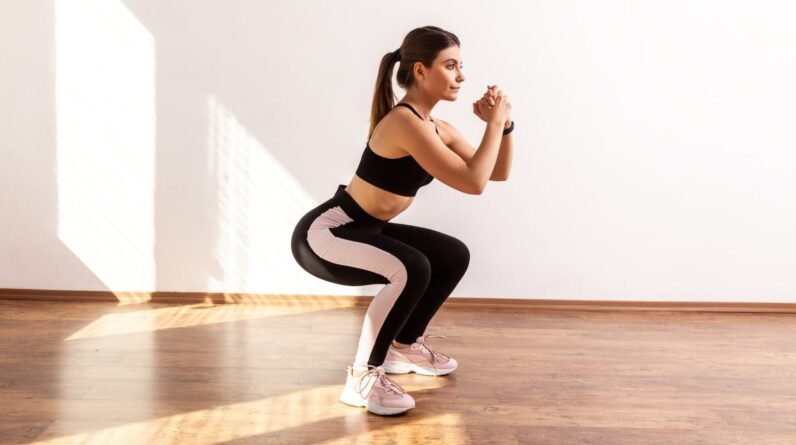
As sprinters Noah Lyles and Sha’Carri Richardson passed their opponents and crossed the finish line in their Olympic medal-winning races, you could see the gargantuan effort they had just put out—as well as pure joy. Their faces conveyed the thrill that comes from running really, really fast. There’s just something about pushing your heart, lungs, and muscles to their max, and moving in a way that’s different from the steady scenes around you, that can make you feel on top of the world.
“It feels empowering,” says running coach Will Baldwin. “You’re feeling a lot of different sensations, you’re breathing hard, and sometimes that can make you feel a little bit alive.”
You might not be setting world records at the Olympics, but you can channel that same feeling by lacing up your sneakers and shifting into a different gear for a few minutes. And really, a few minutes of sprinting is all you need.
How to get started with speed runs
If you want to start running fast, you can try a specific speed workout, or you can tack on some intervals to a more relaxed run or walk.
But first, how fast is fast? Running coaches often use a 1 to 10 pacing system, where an “easy run” is a 2 to 5 effort, a more challenging run a 6 to 8, and a sprint a 9 or a 10. For the following workouts, 6 to 8 is the effort “sweet spot,” says Baldwin, especially for your early intervals. Ratchet up to the end of that range and then into a 9 or a 10 for shorter final intervals.
“If we’re going to do a speed workout, the first rep or two don’t need to be the hardest,” Baldwin says. “Start off a little easier, so you have a place to go throughout the workout.”
You should also remember to always warm up—a good rule of thumb for most types of exercise, but even more crucial in speed running. Running fast means you’re using more of your muscles and extending your range of motion farther than usual. Doing so without getting your blood flowing and raising your internal body temperature can increase the chance of injury (and it will feel way harder).
“It makes it a lot more comfortable and smoother when we start faster stuff,” Baldwin says. “We’re going to use muscles that we don’t normally use that have been just sitting there dormant for a while. And so the more blood flow, the more warmth we can get to them, that’s just going to be safer overall.”
Plan to do a 10 to 15 minute power walk or jog before speed intervals, and cool down with 5 to 10 minutes of jogging or walking, too. Now that that’s settled, we can get to the fun stuff.
3 speed workouts to get you running fast, stat
Whether you’re trying to mix some sprinting intervals into your walks or runs, or you want to set out for a speed workout specifically, we’ve got you covered.
1. Strides
Strides are when you run all out for 20 seconds with a minute of walking in between, somewhere between 4 to 10 times in a row. These are great to tack onto the end or in the middle of a more relaxed run. Baldwin says they’ll also help you get faster at running overall.
“If you were just running easy every day, and you started throwing in six 20-second strides after every run, you would see a huge benefit,” Baldwin says. “Obviously workouts would be that next step, but strides are such a great place to start.”
Strides are an approachable starting point because of how short they are. If pushing yourself feels foreign or uncomfortable, trying it out in manageable chunks can help you get used to the feeling. As Noah Lyles would say, “Why not you?” (at least for 20 seconds).
2. One on, one off
This is Baldwin’s go-to workout for anyone just getting into speed runs, or someone who’s taken time away from them. After your warmup, you’ll run for 1 minute, and then jog or walk for 1 minute. Do that five times in a row, for a total of 10 minutes.
“It’s really fun because you can play it a lot of ways,” Baldwin says. “If you want to really go fast, you can go a little bit faster on the hard portion and walk more of the rest. If you want it a little more aerobic, a little more continuous, you can try try to go as fast as you can on the hard part where you can still jog really slowly for the entire rest portion.”
3. Reverse ladder
5-4-3-2-1, go! That race kickoff also happens to be the run instructions for this speed workout. After your warmup, run for 5 minutes, and then rest (walk or jog) for 2 minutes. At the end of the rest, you’ll run for 4 minutes, and then repeat that process all the way down to your final 1-minute sprint.
“We’ve got to be strategic and not start out too hot for this one,” says Baldwin. “Run at that 5, maybe 6 out of 10 effort. And then we’ll walk it down the ladder, and then hopefully by the end we get to the last minute and we can really go for it.”
Not feeling the joy of sprinting? Make this adjustment
Hold up, Sha’Carri. Even if you’re feeling inspired by Olympic sprinters, Baldwin says going too hard too fast could stop you in your tracks.
“If it’s not fun, we’re probably going too fast,” says Baldwin. “We don’t want it to be miserable and hard, that 9 out of 10 every second when we’re just holding on for dear life.”
Instead, ask yourself what wasn’t fun about the run, and pull back.
“Everyone starts somewhere,” Baldwin says. “We’re really looking to leave a little bit on the plate where it’s like you probably could have done another 2 reps, you could have gone a little bit faster, but we’re leaving that so we’re healthy and we’re comfortable. And then we’re excited to come back and do another one.”







